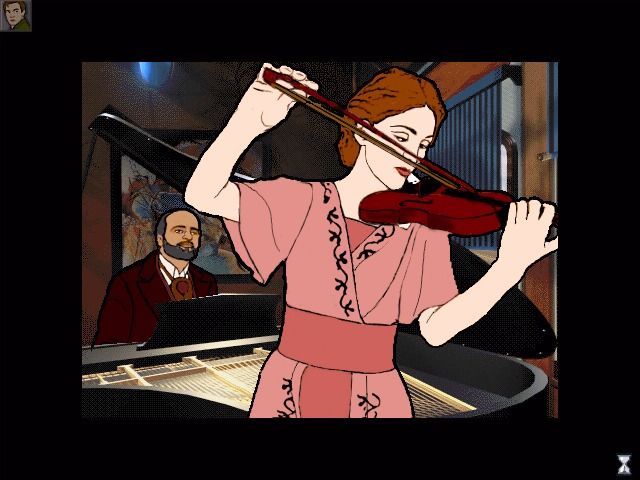Trending
Opinion: How will Project 2025 impact game developers?
The Heritage Foundation's manifesto for the possible next administration could do great harm to many, including large portions of the game development community.

Featured Blog | This community-written post highlights the best of what the game industry has to offer. Read more like it on the Game Developer Blogs or learn how to Submit Your Own Blog Post
Our team is creating a game that is best defined as a real-time story. In this post I cover what a real-time story is, talk about our main influences - The Last Express and Sleep No More - and discuss the design constraints we've chosen for the game.

Wayward Strand is a lot of different things. Its setting is an Australian hospital in the ‘70s. It takes place on an airship originally constructed in Weimar Germany. It’s a real-time story. It’s virtual interactive theatre. It’s a video game in which you play as a character with limited agency - a teenage girl in a world of adults.
It has been difficult to find an entry point to talking about Wayward Strand and its development. But one obvious element that is a differentiating factor for our game (which is also what we’ve spent the most dev time on thus far) is its real-time structure.
I’ve touched on what a real-time story is previously; it’s a story which plays out regardless of whether the player/reader/watcher interacts with it, but nevertheless is reactive to their input. In our case the story reacts both explicitly, as the player character converses with characters in the world, and implicitly, as the player controls their character’s location in the world and stitches together their own version of the story by being present at a particular subset of scenes and events.
Real-time narratives aren’t a common structure in story-focused games, but it has been done before; notably in Smoking Car Production’s The Last Express, an adventure game set on the Orient Express in the days before World War I.

Critically acclaimed but commercially ill-fated, The Last Express is a fascinating experiment in real-time storytelling - you can read interviews on its development here on Gamasutra. Reading about and then playing The Last Express is probably what first got me thinking about the potential of real-time narratives.
The other key inspiration for Wayward Strand’s real-time story is outside of the video game world entirely. In the postmodern theatre movement over the past few decades there has been an exploration of audience not as passive viewers, but as active participants in the performance. This “immersive theatre” experience was pioneered by theatre company Punchdrunk in interactive theatre pieces such as Sleep No More and The Drowned Man.

Several members of our team (most recently Russell and I, earlier this year) have been to Sleep No More, and it is a revelatory experience. There are several elements that make Sleep No More singularly brilliant - the physicality, both of the performers and of you as the audience sharing their space; the mystery of how the performance works and what you’ve become a part of; and the imagination-sparking magic of piecing together a story - your own story - from the fragmented sequence of events that you personally have witnessed.
It’s this last element that excites us the most - that feeling of exploring a narrative space and being encouraged to draw your own conclusions - and that’s part what we are aiming to achieve with Wayward Strand through this real-time narrative framework.
The idea of placing the player character in a realistic world with its own life - its own heartbeat, pace and rhythm - isn’t new. It’s something that I think a lot of budding game designers imagine creating, and it’s been a bit of a white whale for some time in the simulation RPG space.
Because of these reasons, and because of the fact that The Last Express, one of the only examples of a real-time story we can point to, went way over-time and over budget during production, we have been very careful in choosing our design constraints to keep our goals achievable.
One of these constraints is the fixed nature of Wayward Strand’s narrative design. Unlike a simulation RPG, our story does not arise out of a systemic simulation - it is fully authored and bespoke. As in interactive fiction, there may be multiple possible scenes or outcomes that can play out based on player choice, but there is no simulation governing character behaviours or story outcomes. However, because of the real-time nature and the fact that there are multiple story threads being advanced in different areas of the game at the same time, the experience of exploring the story is still player-driven and highly variable.
Another important design constraint in Wayward Strand is the level of player agency. In most games player agency is dialled up to eleven - your player character is in full and complete control of their situation, not only making their own choices. but often making choices on behalf of other characters as well.
What we’re really interested in what happens when you turn down that dial. What happens if you play as a character with limited agency - limited ability to effect change in their world? This is a fascinating area to explore from a writing perspective in a game. By putting the player in the shoes of a character that has specific and understandable constraints to their agency, we’re able to give them a unique and often unseen perspective into the lives of other characters in the world.
While the player is able to exert some influence on many of the stories in the game, we can also present stories that exist totally apart from the player character, that they experience as an observer. Just as in life, the situations that other people are in don’t revolve around you, and sometimes don’t even concern you.
The final notable constraint is time. We’re trying our best to keep the experience of playing Wayward Strand, from beginning to end, under two hours long - roughly the length of your average film. This has a significant and deep effect on our design of the game as a whole - from keeping the interactions as simple as possible, to developing stories that can be told within this time-frame, to creating characters that you don’t need to spend hours with to begin to comprehend and empathise with. It also fits well with our goal of having as little filler as possible, regardless of where on the ship you choose to go to at any given time. Adding more content to the game doesn’t make it longer - it just widens the possibility space.
Hopefully you can tell that we’re incredibly excited about the possibilities of telling stories using this still fairly novel narrative structure. If you know of any examples of games that explore this design space that I didn’t mention, or have thoughts on real-time narratives, I’d love to hear them - just post them in the comments below, or reach out to me on Twitter.
Read more about:
Featured BlogsYou May Also Like